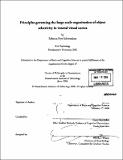Principles governing the large-scale organization of object selectivity in ventral visual cortex
Author(s)
Schwarzlose, Rebecca Frye
DownloadFull printable version (16.51Mb)
Other Contributors
Massachusetts Institute of Technology. Dept. of Brain and Cognitive Sciences.
Advisor
Nancy Kanwisher.
Terms of use
Metadata
Show full item recordAbstract
As our understanding of the brain grows, neuroscientists find themselves increasingly in the role of cartographer. Thus far, cortical maps have been found primarily in early input and late output areas, however they may also occur in higher-level regions of the brain that perform more complex functions. An example of such a region is the objectselective ventral visual cortex (VVC) in humans. This region, which is involved in the high-level task of object recognition, is comprised of several functionally defined, category-selective subregions that are laid out with remarkable systematicity and consistency across individuals. In this thesis, I use fMRI to test several hypotheses about the nature of object representations and the dimensions along which object-selective cortex might be organized. In the first study, I find evidence supporting the existence of domain-specific regions. Results from the second set of studies suggest that temporal associations do not guide the overall organization of VVC, and also provide contradictory evidence against a long-standing hypothesis that the VVC is organized based on conceptual knowledge about objects and, specifically, the distinction between animate and inanimate objects. Instead, my results suggest that associations between objects and motor actions may play a role in the location of category selectivities for a subset of object classes. Results from a third set of studies demonstrate that computational demands for acuity or spatial integration cannot account for location biases in category-selective regions, and instead suggest that experience with objects at specific retinal locations may serve as an organizing dimension. Moreover, these studies reveal systematic differences in the amount of location information contained in category-selective regions on the ventral temporal versus lateral occipital surfaces. (cont) In sum, the studies described in this thesis address several hypotheses about the large-scale organization of VVC, and, in doing so, advance our understanding of the principles that govern the layout of maps in higher-level, object-selective cortex.
Description
Thesis (Ph. D.)--Massachusetts Institute of Technology, Dept. of Brain and Cognitive Sciences, 2008. Page 131 blank. Includes bibliographical references.
Date issued
2008Department
Massachusetts Institute of Technology. Department of Brain and Cognitive SciencesPublisher
Massachusetts Institute of Technology
Keywords
Brain and Cognitive Sciences.